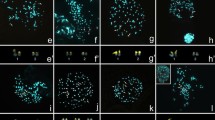Abstract
New data are presented on chromosome numbers for 36 species, two varieties, and two hybrids ofCirsium (Compositae). These include first reports forC. rhothophilum (2n = 34),C. andrewsii (2n = 32),C. crassicaule (2n = 32),C. quercetorum (2n= 32, 112),C. pascuarense (2n= 32),C. douglasii var.canescens (2n = 30, 34),C. hydrophilum (2n = 32),C. neomexicanum (2n = 30),C. cymosum (2n = 30, 34),C. acantholepis (2n= 34),C. radians (2n = 34), C.grahami (2n = 32),C. nigriceps (2n = 36),C. andersonii (2n= 32, 64),C. anartiolepis (2n = 34), andC. subcoriaceum (2n= 34). The published data on chromosome numbers of Eurasian and AmericanCirsium are summarized. In Eurasia, speciation has taken place primarily at the diploid level but is occasionally reinforced by polyploidy. The ancestral base number of 17 has been preserved in almost all species, and there is little evidence that reduction in chromosome number has played a significant role in speciation. In America speciation has proceeded exclusively at the diploid level, but the ancestral genome of 17 chromosomes has been retained in only about half of the species examined. In the remaining species, restructuring of the genome has occurred resulting in a reduction in number from 17 to 9 in extreme cases. Polyploidy, when seen, is of no significance. It is suggested that all species with greatly reduced numbers may represent products of a single reduction series.
Similar content being viewed by others
Literature Cited
Frankton, C. & R. J. Moore 1961. Cytotaxonomy, phylogeny, and Canadian distribution ofCirsium undulatum andCirsium flodmanii. Canad. J. Bot.39: 21–33.
Hooker, J. D. 1871.Cirsium grahami. Bot. Mag., T. 5885.
Howell, J. T. 1960.Cirsium. In L. R. Abrams & R. S. Ferris (eds.), An Illustrated Flora of the Pacific States 4: 514–538.
Moore, R. J. &C. Frankton 1962. Cytotaxonomic studies in the tribeCynareae (Compositae). Canad. J. Bot.40: 281–293.
Ownbey, G. B. 1968. Cytotaxonomic notes on eleven species ofCirsium native to Mexico. Brittonia20: 336–342.
Petrak, F. 1917. Die nordamerikanischen Arten der GattungCirsium. Beih. Bot. Centralbl.35(Abt. 2): 223–567.
Author information
Authors and Affiliations
Additional information
This research was supported in part by National Science Foundation grant GB-2727. Most of the manuscript was prepared under a grant from the Graduate School, University of Minnesota. We are indebted to Thomas K. Fuller for many seed samples and to D. E. Breedlove for fixed material. O. T. Solbrig contributed one chromosome count ; James M. Muggli helped with field work ; and Siu-Tsun Hsi provided many excellent cytological preparations. Costs of publication were met in part from the Junior F. Hayden Memorial Fund, Dept. of Botany, University of Minnesota.
Rights and permissions
About this article
Cite this article
Ownbey, G.B., Raven, P.H. & Kyhos, D.W. Chromosome numbers in some North American species of the genus Cirsium. III. Western United States, Mexico, and Guatemala. Brittonia 27, 297–304 (1975). https://doi.org/10.2307/2805509
Issue Date:
DOI: https://doi.org/10.2307/2805509




